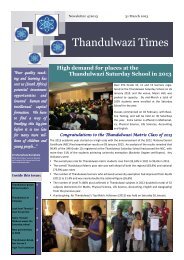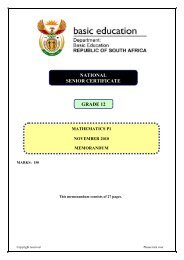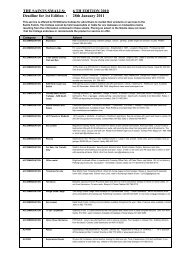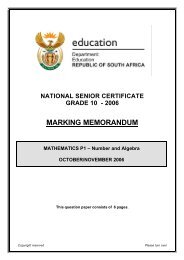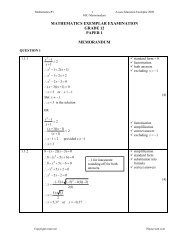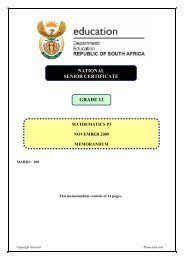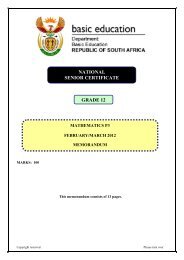You also want an ePaper? Increase the reach of your titles
YUMPU automatically turns print PDFs into web optimized ePapers that Google loves.
NATIONAL<br />
SENIOR CERTIFICATE<br />
GRADE 12<br />
MATHEMATICS P1<br />
NOVEMBER 2009(1)<br />
MARKS: 150<br />
TIME: 3 hours<br />
This question paper consists of 10 pages, an information sheet and 1 diagram sheet.<br />
Copyright reserved<br />
Please turn over
Mathematics/P1 2 DoE/November 2009(1)<br />
NSC<br />
INSTRUCTIONS AND INFORMATION<br />
Read the following instructions carefully before answering the questions.<br />
1.<br />
2.<br />
3.<br />
4.<br />
5.<br />
6.<br />
7.<br />
8.<br />
This question paper consists of 13 questions. Answer ALL the questions.<br />
Clearly show ALL calculations, diagrams, graphs, et cetera that you have used in<br />
determining your answers.<br />
An approved scientific calculator (non-programmable and non-graphical) may be<br />
used, unless stated otherwise.<br />
If necessary, answers should be rounded off to TWO decimal places, unless stated<br />
otherwise.<br />
Diagrams are NOT necessarily drawn to scale.<br />
ONE diagram sheet for answering QUESTION 13.3 is attached at the end of this<br />
question paper. Write your centre number and examination number on these sheets in<br />
the spaces provided and place them in the back of your ANSWER BOOK.<br />
Number the answers correctly according to the numbering system used in this<br />
question paper.<br />
It is in your own interest to write legibly and to present the work neatly.<br />
Copyright reserved<br />
Please turn over
Mathematics/P1 3 DoE/November 2009(1)<br />
NSC<br />
QUESTION 1<br />
1.1 Solve for x:<br />
1.1.1 x ( x −1 ) = 30<br />
(3)<br />
1.1.2 3x 2 − 5x + 1 = 0 (Correct to ONE decimal place) (4)<br />
1.1.3<br />
15x < x<br />
2<br />
− 4 9<br />
(4)<br />
1.2 Solve simultaneously for x and y in the following set of equations:<br />
x − y = 3<br />
x<br />
2<br />
− xy − 2y<br />
2<br />
− 7 = 0<br />
(5)<br />
1.3 Calculate the exact value of:<br />
10<br />
2011<br />
10<br />
−<br />
2009<br />
10<br />
2007<br />
(Show ALL calculations.) (3)<br />
1.4 Simplify completely without the use of a calculator:<br />
QUESTION 2<br />
2<br />
2<br />
2<br />
( 1 2x<br />
) − 8x<br />
+ (3)<br />
[22]<br />
2.1 Tebogo and Matthew's teacher has asked that they use their own rule to construct a<br />
sequence of numbers, starting with 5. The sequences that they have constructed are<br />
given below.<br />
Matthew's sequence:<br />
Tebogo's sequence:<br />
5 ; 9 ; 13 ; 17 ; 21 ; …<br />
5 ; 125 ; 3 125 ; 78 125 ; 1 953 125 ; …<br />
Write down the n th term (or the rule in terms of n) of:<br />
2.1.1 Matthew's sequence (3)<br />
2.1.2 Tebogo's sequence (2)<br />
2.2 Nomsa generates a sequence which is both arithmetic and geometric. The first term<br />
is 1. She claims that there is only one such sequence. Is that correct? Show ALL<br />
your workings to justify your answer. (5)<br />
[10]<br />
Copyright reserved<br />
Please turn over
Mathematics/P1 4 DoE/November 2009(1)<br />
NSC<br />
QUESTION 3<br />
99<br />
Given: ∑(3t<br />
−1)<br />
t = 0<br />
3.1 Write down the first THREE terms of the series. (1)<br />
3.2 Calculate the sum of the series. (4)<br />
[5]<br />
QUESTION 4<br />
The following sequence of numbers forms a quadratic sequence:<br />
– 3 ; – 2 ; – 3 ; – 6 ; – 11 ; …<br />
4.1 The first differences of the above sequence also form a sequence. Determine an<br />
expression for the general term of the first differences. (3)<br />
4.2 Calculate the first difference between the 35 th and 36 th terms of the quadratic<br />
sequence. (2)<br />
4.3 Determine an expression for the n th term of the quadratic sequence. (4)<br />
4.4 Explain why the sequence of numbers will never contain a positive term. (2)<br />
[11]<br />
QUESTION 5<br />
Data regarding the growth of a certain tree has shown that the tree grows to a height of 150 cm<br />
after one year. The data further reveals that during the next year, the height increases by 18 cm.<br />
In each successive year, the height increases by 9<br />
8 of the previous year's increase in height. The<br />
table below is a summary of the growth of the tree up to the end of the fourth year.<br />
Tree height (cm)<br />
Growth (cm)<br />
First year Second year Third year Fourth year<br />
150 168 184<br />
2<br />
198<br />
9<br />
18 16<br />
2<br />
14<br />
9<br />
5.1 Determine the increase in the height of the tree during the seventeenth year. (2)<br />
5.2 Calculate the height of the tree after 10 years. (3)<br />
5.3 Show that the tree will never reach a height of more than 312 cm. (3)<br />
[8]<br />
Copyright reserved<br />
Please turn over
Mathematics/P1 5 DoE/November 2009(1)<br />
NSC<br />
QUESTION 6<br />
1<br />
Sketched below are the graphs of<br />
2<br />
P and Q are the points of intersection of f and g.<br />
1<br />
g = . x + 1<br />
2<br />
f ( x)<br />
= x and ( x)<br />
− + 1<br />
y<br />
g<br />
f<br />
P<br />
Q<br />
g<br />
0<br />
x<br />
6.1 Show that the coordinates of P and Q are P(– 2 ; 2) and Q(1 ; 2<br />
1 ) respectively. (6)<br />
6.2 An axis of symmetry of the graph of g is a straight line defined as y = mx + c ,<br />
where m > 0 . Write down the equation of this straight line in the form y = h(x)<br />
= K (2)<br />
−1<br />
6.3 Determine the equation of h in the form<br />
y = K<br />
(2)<br />
⎛ 1 ⎞<br />
6.4 Show algebraically that g ( x)<br />
+ g⎜<br />
⎟ = g(<br />
−x).<br />
g(<br />
x −1)<br />
. (x ≠ 0 or x ≠ 1) (3)<br />
⎝ x ⎠<br />
[13]<br />
Copyright reserved<br />
Please turn over
Mathematics/P1 6 DoE/November 2009(1)<br />
NSC<br />
QUESTION 7<br />
The graphs of<br />
f ( x)<br />
= 3cos<br />
x and g ( x)<br />
= sin( x − 60°<br />
) are sketched below for x ∈[ −180°<br />
; 90°<br />
] .<br />
y<br />
3<br />
2<br />
f<br />
1<br />
B<br />
-180 -150 -120 -90 -60 -30 0 30 60 90<br />
A<br />
g<br />
-1<br />
x<br />
-2<br />
-3<br />
7.1 Write down the range of f .<br />
(1)<br />
7.2 If A(– 97,37° ; – 0,38), write down the coordinates of B. (3)<br />
7.3 Write down the period of g ( 3x)<br />
.<br />
(2)<br />
7.4 Write down a value of x for which g( x)<br />
− f ( x)<br />
is a maximum. (2)<br />
[8]<br />
Copyright reserved<br />
Please turn over
Mathematics/P1 7 DoE/November 2009(1)<br />
NSC<br />
QUESTION 8<br />
Sketched below is the graph of ( x)<br />
= −log<br />
x .<br />
y<br />
f<br />
2<br />
2<br />
1<br />
O<br />
1 2 3 4 5 6 7 8<br />
x<br />
-1<br />
-2<br />
f<br />
-3<br />
-4<br />
8.1 Write down the domain of f. (1)<br />
−1<br />
8.2 Write down the equation of f in the form y = …<br />
(1)<br />
−1<br />
8.3 Write down the equation of the asymptote of f .<br />
(1)<br />
8.4 Explain how, using the graph of f, you would sketch the graphs of:<br />
8.4.1 ( x)<br />
= log x<br />
(1)<br />
g<br />
2<br />
8.4.2 h ( x)<br />
= 2<br />
− x − 5<br />
(3)<br />
8.5 Use the graph of f to solve for x where log 2<br />
x < 3 . (3)<br />
[10]<br />
Copyright reserved<br />
Please turn over
Mathematics/P1 8 DoE/November 2009(1)<br />
NSC<br />
QUESTION 9<br />
9.1 A photocopier valued at R24 000 depreciates at a rate of 18% p.a. on the reducingbalance<br />
method. After how many years will its value be R15 000? (4)<br />
9.2 A car that costs R130 000 is advertised in the following way: 'No deposit necessary<br />
and first payment due three months after date of purchase.' The interest rate quoted is<br />
18% p.a. compounded monthly.<br />
9.2.1 Calculate the amount owing two months after the purchase date, which is<br />
one month before the first monthly payment is due. (3)<br />
9.2.2 Herschel bought this car on 1 March 2009 and made his first payment on<br />
1 June 2009. Thereafter he made another 53 equal payments on the first<br />
day of each month.<br />
(a) Calculate his monthly repayments. (3)<br />
(b) Calculate the total of all Herschel's repayments. (1)<br />
9.2.3 Hashim also bought a car for R130 000. He also took out a loan for<br />
R130 000, at an interest rate of 18% p.a. compounded monthly. He also<br />
made 54 equal payments. However, he started payments one month after<br />
the purchase of the car. Calculate the total of all Hashim's repayments.<br />
(4)<br />
9.2.4 Calculate the difference between Herschel's and Hashim's total<br />
repayments. (1)<br />
[16]<br />
QUESTION 10<br />
10.1 Differentiate f (x) from first principles if f ( x)<br />
= −2x<br />
2 + 3 .<br />
(5)<br />
dy<br />
10.2 Evaluate: if<br />
2 1<br />
y = x −<br />
dx<br />
3<br />
(2)<br />
2x<br />
[7]<br />
Copyright reserved<br />
Please turn over
Mathematics/P1 9 DoE/November 2009(1)<br />
NSC<br />
QUESTION 11<br />
3 2<br />
Given: f ( x)<br />
= −x<br />
+ x + 8x<br />
−12<br />
11.1 Calculate the x-intercepts of the graph of f. (5)<br />
11.2 Calculate the coordinates of the turning points of the graph of f. (5)<br />
11.3 Sketch the graph of f, showing clearly all the intercepts with the axes and turning<br />
points. (3)<br />
11.4 Write down the x-coordinate of the point of inflection of f. (2)<br />
11.5 Write down the coordinates of the turning points of h ( x)<br />
= f ( x)<br />
− 3. (2)<br />
[17]<br />
QUESTION 12<br />
A tourist travels in a car over a mountainous pass during his trip. The height above sea level of<br />
3 2<br />
the car, after t minutes, is given as s(<br />
t)<br />
= 5t<br />
− 65t<br />
+ 200t<br />
+ 100 metres. The journey lasts<br />
8 minutes.<br />
12.1 How high is the car above sea level when it starts its journey on the mountainous<br />
pass? (2)<br />
12.2 Calculate the car's rate of change of height above sea level with respect to time,<br />
4 minutes after starting the journey on the mountainous pass. (3)<br />
12.3 Interpret your answer to QUESTION 12.2. (2)<br />
12.4 How many minutes after the journey has started will the rate of change of height with<br />
respect to time be a minimum? (3)<br />
[10]<br />
Copyright reserved<br />
Please turn over
Mathematics/P1 10 DoE/November 2009(1)<br />
NSC<br />
QUESTION 13<br />
A steel manufacturer makes two kinds of products, product A and B, having parts that must be<br />
cut, assembled and finished. The manufacturer is aware that it can sell as many products as it<br />
can produce.<br />
Let x and y be the number of units of product A and product B that are manufactured every day<br />
respectively.<br />
The constraints that govern the manufacture of the products are represented below and the<br />
feasible region is shaded.<br />
14<br />
y<br />
13<br />
12<br />
Number of units of product B<br />
11<br />
10<br />
9<br />
8<br />
7<br />
6<br />
5<br />
4<br />
3<br />
2<br />
1<br />
Feasible<br />
Region<br />
1 2 3 4 5 6 7 8 9 10 11 12 13 14 15 16 17 18<br />
Number of units of product A<br />
x<br />
13.1 Write down the constraints in terms of x and y that represent the above information. (7)<br />
13.2 If product A yields a profit of R30 per item and product B yields R40 per item, write<br />
down the equation indicating the daily profit in terms of x and y. (2)<br />
13.3 Determine the number of units of product A and product B that the manufacturer<br />
needs to produce in order to maximise his daily profit. A diagram is provided on<br />
DIAGRAM SHEET 1. (2)<br />
13.4 The manufacturer would like the maximum profit to be at (6 ; 2) for the profit<br />
equation P = mx + c. Determine the values of m which will satisfy this condition (2)<br />
[13]<br />
TOTAL: 150<br />
Copyright reserved
Mathematics/P1 DoE/November 2009(1)<br />
NSC<br />
INFORMATION SHEET: MATHEMATICS<br />
− b ± b<br />
2 − 4 ac<br />
x =<br />
2a<br />
A = P( 1+<br />
ni)<br />
A = P( 1−<br />
ni)<br />
A = P( 1−<br />
i)<br />
n<br />
A = P( 1+<br />
i)<br />
n<br />
n<br />
∑<br />
i=<br />
1<br />
n<br />
∑<br />
i=<br />
1<br />
1 = n<br />
ar<br />
F =<br />
i−1<br />
x<br />
n<br />
( r −1)<br />
a<br />
=<br />
r −1<br />
n<br />
[( 1+<br />
i)<br />
−1]<br />
i<br />
n<br />
∑<br />
i=<br />
1<br />
; r ≠ 1 ∑ ∞<br />
i=<br />
1<br />
n(<br />
n + 1)<br />
i =<br />
2<br />
−n<br />
x[1 − (1 + i) ]<br />
P =<br />
i<br />
a<br />
=<br />
1−<br />
r<br />
n<br />
∑( a + ( i −1)<br />
d ) = ( 2a<br />
+ ( n −1)<br />
d )<br />
i=<br />
1<br />
i−1<br />
ar ; −1 < r < 1<br />
f ( x + h)<br />
− f ( x)<br />
f '(<br />
x)<br />
= lim<br />
h → 0 h<br />
d = ( x )<br />
2<br />
( )<br />
2<br />
2<br />
− x1<br />
+ y<br />
2<br />
− y<br />
M ⎛ x1 + x2<br />
y1<br />
+ y2<br />
1<br />
⎟ ⎞<br />
⎜ ;<br />
⎝ 2 2 ⎠<br />
y = mx + c<br />
y − y = m x − )<br />
2<br />
2 2<br />
( x − a) + ( y − b) = r<br />
1<br />
( x1<br />
2<br />
1<br />
n<br />
2<br />
y2<br />
− y1<br />
m = m = tanθ<br />
x − x<br />
In ΔABC:<br />
sin<br />
a<br />
A<br />
b c<br />
= =<br />
a<br />
2<br />
b<br />
2<br />
c<br />
2<br />
1<br />
= + − 2bc.<br />
cos A area Δ ABC = ab.<br />
sin C<br />
sin B sin C<br />
2<br />
( α + β ) = sinα.cos<br />
β cosα.<br />
sin β sin( α − β ) = sinα.cos<br />
β − cosα.<br />
sin β<br />
sin +<br />
cos<br />
( α + β ) = cosα.cos<br />
β − sinα.<br />
sin β cos ( α − β ) = cosα.cos<br />
β + sinα.<br />
sin β<br />
2<br />
2<br />
⎧cos<br />
α − sin α<br />
⎪<br />
2<br />
cos 2α = ⎨1<br />
− 2sin α<br />
sin 2α<br />
= 2sinα.<br />
cosα<br />
⎪ 2<br />
⎩2cos<br />
α −1<br />
∑( xi<br />
− x)<br />
=<br />
2<br />
σ =<br />
i=<br />
1<br />
∑ fx<br />
x<br />
n<br />
n(<br />
A)<br />
P( A)<br />
= P(A or B) = P(A) + P(B) – P(A and B)<br />
n<br />
( S)<br />
n<br />
n<br />
2<br />
y ˆ = a + bx<br />
b<br />
( x − x)<br />
∑<br />
∑<br />
( y − y)<br />
=<br />
2<br />
( x − x)<br />
Copyright reserved
Mathematics/P1 DoE/November 2009(1)<br />
NSC<br />
CENTRE NUMBER:<br />
EXAMINATION NUMBER:<br />
DIAGRAM SHEET 1<br />
QUESTION 13.3<br />
14<br />
y<br />
13<br />
12<br />
Number of units of product B<br />
11<br />
10<br />
9<br />
8<br />
7<br />
6<br />
5<br />
4<br />
3<br />
2<br />
1<br />
1 2 3 4 5 6 7 8 9 10 11 12 13 14 15 16 17 18<br />
Number of units of product A<br />
x<br />
Copyright reserved



